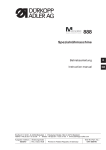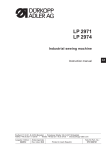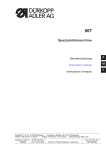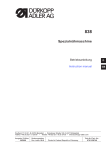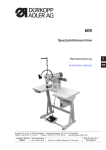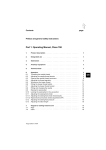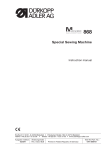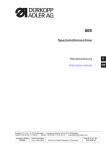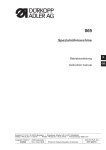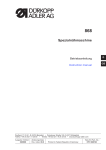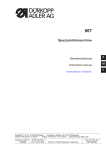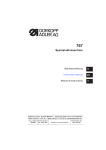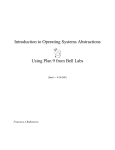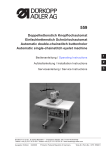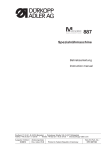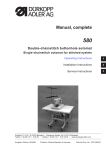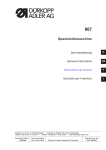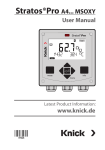Download Operating Instructions
Transcript
888 Spezialnähmaschine Betriebsanleitung D Instruction manual GB Postfach 17 03 51, D-33703 Bielefeld • Potsdamer Straße 190, D-33719 Bielefeld Telefon +49 (0) 521 / 9 25-00 • Telefax +49 (0) 521 / 9 25 24 35 • www.duerkopp-adler.com Ausgabe / Edition: 02/2009 Änderungsindex Rev. index: 03.0 Printed in Federal Republic of Germany Teile-Nr./Part.-No.: 0791 888740 Alle Rechte vorbehalten. Eigentum der Dürkopp Adler AG und urheberrechtlich geschützt. Jede, auch auszugsweise Wiederverwendung dieser Inhalte ist ohne vorheriges schriftliches Einverständnis der Dürkopp Adler AG verboten. All rights reserved. Property of Dürkopp Adler AG and copyrighted. Reproduction or publication of the content in any manner, even in extracts, without prior written permission of Dürkopp Adler AG, is prohibited. Copyright © Dürkopp Adler AG - 2009 Foreword This instruction manual is intended to help the user to become familiar with the machine and take advantage of its application possibilities in accordance with the recommendations. The instruction manual contains important information on how to operate the machine securely, properly and economically. Observation of the instructions eliminates danger, reduces costs for repair and down-times, and increases the reliability and life of the machine. The instruction manual is intended to complement existing national accident prevention and environment protection regulations. The instruction manual must always be available at the machine/sewing unit. The instruction manual must be read and applied by any person that is authorized to work on the machine/sewing unit. This means: – – – Operation, including equipping, troubleshooting during the work cycle, removing of fabric waste, Service (maintenance, inspection, repair) and/or Transport. The user also has to assure that only authorized personnel work on the machine. The user is obliged to check the machine at least once per shift for apparent damages and to immediatly report any changes (including the performance in service), which impair the safety. The user company must ensure that the machine is only operated in perfect working order. Never remove or disable any safety devices. If safety devices need to be removed for equipping, repairing or maintaining, the safety devices must be remounted directly after completion of the maintenance and repair work. Unauthorized modification of the machine rules out liability of the manufacturer for damage resulting from this. Observe all safety and danger recommendations on the machine/unit! The yellow-and-black striped surfaces designate permanend danger areas, eg danger of squashing, cutting, shearing or collision. Besides the recommendations in this instruction manual also observe the general safety and accident prevention regulations! General safety instructions The non-observance of the following safety instructions can cause bodily injuries or damages to the machine. 1. The machine must only be commissioned in full knowledge of the instruction book and operated by persons with appropriate training. 2. Before putting into service also read the safety rules and instructions of the motor supplier. 3. The machine must be used only for the purpose intended. Use of the machine without the safety devices is not permitted. Observe all the relevant safety regulations. 4. When gauge parts are exchanged (e.g. needle, presser foot, needle plate, feed dog and bobbin) when threading, when the workplace is left, and during service work, the machine must be disconnected from the mains by switching off the master switch or disconnecting the mains plug. 5. Daily servicing work must be carried out only by appropriately trained persons. 6. Repairs, conversion and special maintenance work must only be carried out by technicians or persons with appropriate training. 7. For service or repair work on pneumatic systems, disconnect the machine from the compressed air supply system (max. 7-10 bar). Before disconnecting, reduce the pressure of the maintenance unit. Exceptions to this are only adjustments and functions checks made by appropriately trained technicians. 8. Work on the electrical equipment must be carried out only by electricians or appropriately trained persons. 9. Work on parts and systems under electric current is not permitted, except as specified in regulations DIN VDE 0105. 10. Conversion or changes to the machine must be authorized by us and made only in adherence to all safety regulations. 11. For repairs, only replacement parts approved by us must be used. 12. Commissioning of the sewing head is prohibited until such time as the entire sewing unit is found to comply with EC directives. 13. The line cord should be equipped with a country-specific mains plug. This work must be carried out by appropriately trained technicians (see paragraph 8). It is absolutely necessary to respect the safety instructions marked by these signs. Danger of bodily injuries ! Please note also the general safety instructions. Table of contents page: Introduction and safety instructions Part 1: Operating Instructions Class 888 (Edition 02/2009) 1. Product description . . . . . . . . . . . . . . . . . . . . . . . . . . . . . . . . . . . . . . . . . . . 5 2. Designated use . . . . . . . . . . . . . . . . . . . . . . . . . . . . . . . . . . . . . . . . . . . . . . 5 3. 3.1 3.2 Subclasses and sewing equipment Subclasses . . . . . . . . . . . . . . . . . . . . . . . . . . . . . . . . . . . . . . . . . . . . . . . . . . Sewing equipment. . . . . . . . . . . . . . . . . . . . . . . . . . . . . . . . . . . . . . . . . . . . . . 6 7 4. Optional equipment . . . . . . . . . . . . . . . . . . . . . . . . . . . . . . . . . . . . . . . . . . . . 9 5. 5.1 5.2 Technical data Technical data class . . . . . . . . . . . . . . . . . . . . . . . . . . . . . . . . . . . . . . . . . . . . Technical data subclasses . . . . . . . . . . . . . . . . . . . . . . . . . . . . . . . . . . . . . . . . . 10 10 6. 6.1 6.2 6.3 6.4 6.4.1 6.4.2 6.5 6.5.1 Operation Threading the needle thread . . . . . . . . . . . . . . . . . . . . . . . . . . . . . . . . . . . Winding the hook thread . . . . . . . . . . . . . . . . . . . . . . . . . . . . . . . . . . . . . . Bobbin insertion and threading the hook thread . . . . . . . . . . . . . . . . . . . . . . . Adjusting the thread tension . . . . . . . . . . . . . . . . . . . . . . . . . . . . . . . . . . . . Adjusting the hook thread tension . . . . . . . . . . . . . . . . . . . . . . . . . . . . . . . . Adjusting the needle thread tension . . . . . . . . . . . . . . . . . . . . . . . . . . . . . . . Switching on/off the thread tensioners . . . . . . . . . . . . . . . . . . . . . . . . . . . . . Function of the thread main tension and the thread supplementary tension in relation to the sewing foot lifting . . . . . . . . . . . . . . . . . . . . . . . . . . . . . . . . . . . . . . Adjusting the thread regulator. . . . . . . . . . . . . . . . . . . . . . . . . . . . . . . . . . . Changing the needle with single-needle machines with the hook on the right . . . . . . Changing the needle with single-needle machines with the hook on the left (machine with lower thread trimmer) . . . . . . . . . . . . . . . . . . . . . . . . . . . . . . . Changing the needle with double-needle machines . . . . . . . . . . . . . . . . . . . . . Lifting and folding the roller presser . . . . . . . . . . . . . . . . . . . . . . . . . . . . . . . Sewing-foot pressure . . . . . . . . . . . . . . . . . . . . . . . . . . . . . . . . . . . . . . . . Setting through the setting wheel. . . . . . . . . . . . . . . . . . . . . . . . . . . . . . . . . Constant sewing-foot pressure through the cylinder . . . . . . . . . . . . . . . . . . . . . Sewing backward (feeding backward; backtacking). . . . . . . . . . . . . . . . . . . . . . Setting the stitch length . . . . . . . . . . . . . . . . . . . . . . . . . . . . . . . . . . . . . . Switching on the safety clutch at the hook blocking . . . . . . . . . . . . . . . . . . . . . . Starting the manually controlled machine with the clutch motor . . . . . . . . . . . . . . Operating the machine equipped with the positioning motor . . . . . . . . . . . . . . . . Using the pedal . . . . . . . . . . . . . . . . . . . . . . . . . . . . . . . . . . . . . . . . . . . Using the key. . . . . . . . . . . . . . . . . . . . . . . . . . . . . . . . . . . . . . . . . . . . . 6.6 6.7 6.8 6.9 6.10 6.11 6.11.1 6.11.2 6.12 6.13 6.14 6.15 6.16 6.16.1 6.16.2 . . . . . . . . . . . . . . . . . . . . . 12 13 13 14 14 16 18 . . . . . . . . . . . . 19 20 21 . . . . . . . . . . . . . 22 23 24 25 25 26 26 27 28 29 29 30 31 . . . . . . . . . . . . . . . . . . . . . . . . . . . . . . . . . . . . . . . . . . . . . . GB Contents page: 6.17 6.17.1 6.17.2 6.17.3 Material edge trimmer control . Switching on/off edge trimmer Switching on/off material guide Material guide adjustment . . . . . . . . . . . . . . . . . . . . . . . . . . . . . . . . . . . . . . . . . . . . . . . . . . . . . . . . . . . . . . . . . . . . . . . . . . . . . . . . . . . . . . . . . . . . . . . . . . . . . . . . . . . . . . . . . . . . . . . . . . . . . . . . . . . . . . . . . . . . . . . . . . . . . . . . . . . 33 33 34 35 7. Positioning drive Efka DC1550/DA321G . . . . . . . . . . . . . . . . . . . . . . . . . . . . . . . 35 8. 8.1 8.2 Sewing with machine equipped with positioning motor Machine automatic function . . . . . . . . . . . . . . . . . . . . . . . . . . . . . . . . . . . . . . . . Example of machine operation at sewing . . . . . . . . . . . . . . . . . . . . . . . . . . . . . . . 37 38 9. 9.1 9.2 Maintenance Cleaning and checking . . . . . . . . . . . . . . . . . . . . . . . . . . . . . . . . . . . . . . . . . . Lubrication . . . . . . . . . . . . . . . . . . . . . . . . . . . . . . . . . . . . . . . . . . . . . . . . . . 38 42 1. Product description The Dürkopp Adler 888 is a special sewing machine for universal use. 2. • • It is a double lockstitch post bed sewing machine . • Depending on subclass, the machine is either single needle or double needle unit with automatic functions such as thread trimming, automatic backtacking, automatic foot lifting, or without them. • The single needle machine can be equipped with edge trimming with a hook post to the left of the needle. • • • • The machine is equipped with a large two part vertical hook. • The throat plate has replaceable inserts with the stitch hole dimension difference, which are optional in dependence on the needle number. • The machine has automatic wick lubrication from the central oil tank with a visual check of the oil level by oil level indicator in the machine arm. The part of the oil with which the hook is lubricated is devaluated. The other part of the lubrication oil is returned to the central tank by a pump. • Integrated bobbin winder. It has a two step feed. A lower wheel feeder and a driven roller presser feed in two steps, a needle feed feeds in the first step only. In single needle machines, the first step represents 50% of the total stitch length; in double needle machines it represents 30%. Maximum foot lift is 12 mm. The residual thread length after thread trimming is about 15 mm. The hook is protected with a safety clutch against the disarrangement of the adjusted position at the blocking of the thread which interfered with its way. GB Designated use The class 888 is designated for sewing shoe, leather, and upholstery sewing. In general, the material sewn is leather (natural or artificial). It is possible to use it for shoe fabrics too. The equipment for light, medium or heavy sewing is mounted on the machine as an option. The subclass with material trimming is designated especially for the shoe lining trimming if the lining has the corresponding strength. The cutting mechanism allows the lining trimming under the leather surface layer. It is possible to trim also all sewn layers. It is possible to sew dry material only which may not be thicker than 7 mm when pressed down with a roller presser. The material may not contain hard objects, as the machine is not equipped with an eye guard. This machine may be operated in dry rooms and by a trained person only who is aware of the risks described in this instruction. This special sewing machine may be set up and operated only in dry, well-maintained premises. If the sewing machine is used in premises which are not dry and well-maintained it may be necessary to take further precautions (which should be agreed in advance - see EN 60204-31:1999). 5 As manufacturers of industrial sewing machines we proceed on the assumption that personnel who work on our products will have received training at least sufficient to acquaint them with all normal operations and with any hazards which these may involve. 6 0888 160020 X X X 0888 160122 X X X X 0888 160152 X X X X 0888 160522 X X X 0888 260020 X X X 0888 260122 X X X 0888 260522 X X X X X X X X X X X X X X X X X 0888 356122 X X X X 0888 356152 X X X X X X X X 0888 356020 Trimming and backtacking with trimming, automatic backtacking Hook without trimming, manual backtacking Machine control manual lower trimming to the right of the needle Material trimming without trimming up to 7 mm up to 5 mm Stitch length 1 needle, hook to the left of the needle 2 needles Needle number 1 needle, hook to the right of the needle Class and subclasses standard Subclasses big, two parts 3.1 automatic foot lifting and pneumatic backtacking Subclasses and sewing equipment automatic foot lifting and electric backtacking 3. X X X X X X X X X X X 888-E2 888-E3 0888 356122 888-E7/1,5 0888 356020 888-E6/1,2 1/min 1/min 70-80 70 80-60 60 4 3000 2500 mm mm mm mm - - - - - - - 0,8 - 1,0 - 1,2 - 1,5 1,2 - 1,6 - 2,0 - 1,6 - 2,0 - 5 2,4 - 4 2,0 - 2,4 - 3,2 - - - - - - - Noise ** mm Trimming distance from the needle Standard * - Seam distance Maximum - Wheel feed tooth pitch Maximum stitch length 0,01 mm Top roller diameter Standard Sewing speed Scope Polyester thread label number Needle number Standard 0,01 mm dB (A) 0,6 1 888-E4/0,8 888-E5/1,0 Sewing category light Scope 0888 160020 0888 160122 0888 160522 888-E1 Number of needles For classes and subclasses Sewing equipment Sewing equipment 3.2 medium 90-110 90 50-30 40 5 2500 2500 heavy *** 120-160 120 25-10 20 7 2000 1600 light 70-80 70 80-60 60 4 3000 2500 medium 90-110 90 50-30 40 5 2500 2500 1 35 1,2 25 heavy 120-160 120 25-10 20 5 2000 0,6 888-E8/1,2 light 888-E9/1,6 70-80 70 80-60 60 4 3000 GB 1600 2500 888-E10/2,0 888-E11/1,6 888-E12/2,0 888-E13/2,4 0888 260020 0888 260122 0888 260522 0,6 4 2 medium 90-110 90 50-30 40 888-E14/2,0 888-E15/2,4 heavy 120-160 120 25-10 20 888-E17 888-E19 888-E22 * 5 2500 2000 2000 35 1600 1,2 5 0888 160020 0888 160122 0888 160522 888-E16/3,2 4 25 1 medium 90-110 90 50-30 40 5 2500 2500 1,2 25 0,6 25 When sewing very thick layers, it is necessary to reduce the sewing speed significantly; at the parallel sewing and trimming too. ** Acoustic pressure level of a separate machine in the workplace. Measured at the maximum stitch length and maximum sewing speed in compliance with DIN 45635-48-A-1-KL2. *** A pneumatically controlled machine 0888 160522 can have a needle No. 200. 7 888-E20/2,0 888-E21/2,4 medium 2 888-E24 888-E25 888-E26/0,8 888-E27/1,0 888-E28/1,2 888-E29/1,5 * 0888 356152 888-E23 0888 160152 888-E30/1,6 light - mm min min -1 0,01 mm mm 90-110 90 4 25 120-160 120 5 35 mm mm mm 1,6 - 2,0 - 35 2,4 - 35 1,6 - - - - - - - - 0,8 - 1,0 - 1,2 - 1,5 Noise ** Trimming distance from the needle Seam distance Wheel feed tooth pitch Standard * Top roller diameter Sewing speed Maximum Maximum stitch length Standard Scope Polyester thread label number Needle number Standard Scope Sewing category Number of needles For classes and subclasses 0888 260020 0888 260122 0888 260522 Sewing equipment 888-E18/1,6 - -1 0,01 mm dB (A) 1,2 120-160 120 90-110 90 70-80 70 50-30 40 5 2500 2500 4 80-60 60 4 3000 2500 0,6 1 medium 90-110 90 50-30 40 5 2500 2500 heavy 120-160 120 25-10 20 7 2000 1600 light 70-80 70 80-60 60 4 2000 medium 90-100 90 50-30 40 5 2500 25 1,2 25 1 heavy 120-160 120 25-10 20 5 2000 1600 0,6 When sewing very thick layers, it is necessary to reduce the sewing speed significantly; at the parallel sewing and trimming too. ** Acoustic pressure level of a separate machine in the workplace. Measured at the maximum stitch length and maximum sewing speed in compliance with DIN 45635-48-A-1-KL2. 8 4. Optional equipment Order number Optional equipment 0888 220334 Roller presser Æ 25 mm knurled 0888 220344 Roller presser Æ 25 mm smooth 0888 220354 Roller presser Æ 25 mm rubberized 0888 220364 Roller presser Æ 35 mm knurled (basic) 0888 220374 Roller presser Æ 35 mm smooth 0888 220384 Roller presser Æ 35 mm rubberized 0888 220394 Roller presser Æ 45 mm, width 3.8 mm 0888 220404 Roller presser Æ 45 mm, width 2.0 mm 9880 888100 Diode lamp MG55 400334 Stand set MG55-3 for the machine driven with a V-belt (contains a frame, pedal, drawer and a table top 1060 x 500 mm) MG55 400324 Stand set MG55-3 for the machine driven with a toothed belt (contains a frame, pedal, drawer and a table top 1060 x 50 mm) 0700 088802 Stand top plate for the V-belt 0700 088804 Stand top plate for the toothed belt N800 080030 Edge-guide, swivelling N800 080004 Roller stop 9805 791113 USB memory key for data transmission to Efka DA321G drive control 0867 490010 Efka V810 or V820 control panel bracket 0688 130384 Knee lever for mechanical foot lifting 9780 000108 WE-8 maintenance unit for pneumatic optional equipments 0797 003031 Pneumatic connection package 9880 888101 Sewing lamp LED GB 9 5. Technical data 5.1 Technical data class Type of stitch Lockstitch 301 Needle system 134LR, 134 KKLR, 134, 134 D Foot lifting with a hand lever 6 mm Foot lifting with a knee lever or automatically 12 mm Thread length after trimming max. 15 mm Machine head clearance height 300 mm Machine head clearance width 280 mm Machine base plate plan dimensions 178 x 518 mm Table top plan dimensions 1060 x 500 mm Table top minimum height 740 mm Table top maximum height 900 mm Machine height max. 1630 mm Maximum input (short-time) 0,8 kW Operating pressure 6 bar 10 Trimming knife oscillation frequency mm mm 1/min 55 19 - - 60 - - 10 57 60 - - 10 59 57 - - 10 52,5 56 19 - - 61 - - 10 61 - - 10 57 19 - - 62 - - 10 59 - - 10 0888-160020 59 0888-160122 59 - 0888-160152 0888-160522 1 170 52 0888-356020 - kg Stand weight kg Machine head weight kg Trimming knife maximum lift Number of needles kg mm kg Efka DC1550 motor weight Trimmed material maximum thickness mm Efka DC1600 motor weight Post length perpendicular to the sewing direction mm Class and subclasses FIR motor weight Post length in the sewing direction Technical data subclasses Post height 5.2 - 30 0888-356122 52,5 0888-356152 50,5 2,5 3000 2,4 0888-260020 0888-260122 2 170 52 102 - - 0888-260522 - GB More detail about the technical data are given in the chapter 3.2. 11 6. Operation 6.1 Threading the needle thread B A 1 4 C D 3 2 3 1 2 3 E 2 Caution! Risk of injury! Turn off the main switch. The needle thread may only be threaded with the sewing machine switched off. – – – – – – 12 Thread the single needle machine according to fig. (A). If the machine is equipped for heavy sewing, wind the thread around the pin (1). Thread the double needle machine according to fig. (B). The thread (2) designed for the left needle is to be threaded in the left tensioners and in the upper hole in the thread lever (4). Thread the needles arranged side by side according to fig. (B). Thread the diagonally arranged needles according to fig. (C-right needle) and fig. (D-left needle). Thread the machine with an edge trimming mechanism according to the fig. (E). If the machine is equipped for heavy sewing, wind the threads around the pin (5). 6.2 Winding the hook thread 2 – – – – – – 3 4 Thread the thread according to the picture. Insert the thread under the knife (1) and tear off by pulling in the arrow direction (2). Fix the bobbin and press the lever (3) in the direction (4). Start the machine up. After the thread winding, slide the thread under the knife again (1) and tear it off. Insert another bobbin immediately and press the lever (3). Inserting the bobbin and threading the hook thread GB 2 3 10 6.3 1 6 1 4 5 Caution! Risk of injury! Switch the main switch off and wait till the motor stops. – – – – – Tilt the shutter (1) up. Insert the bobbin (2) with the thread end (3) oriented according to the picture. Thread the thread through the slit (4) and space (5), hook upon the shutter (1) and fasten it under the spring (6). Trim the thread ends according to the picture. If the hook is located to the left of the needle, fix the bobbin and do the threading in a similar way. 13 6.4 Adjusting the thread tension 6.4.1 Adjusting the hook thread tension 1 3 2 Caution! Risk of injury! Turn off the main switch. The hook thread tension may only be adjusted with the machine switched off. – – – Adjust the hook thread tension via the screw (1). Insert a screwdriver through the hole (2). Increase the tension by tightening the screw. Measure the thread tension with a dynamometer. Thread the thread according to the picture and pull in the arrow direction (3). This tension is adjusted in the factory in dependence on the selected sewing equipment according to the table below, and it is suitable for the usual sewing operations. For sewing thin soft materials, it is necessary to reduce the tension. If the seam is to be tightened strongly, it is necessary to increase the tension and reduce the sewing speed at the same time. Thread tension of the hook located to the left of the needle is adjusted and measured in a similar way. For this hook, the tension is set up by 10 - 20 % lower than for the hook on the right. Hook thread tension mean value 14 Sewing category Used needle-Number Thread tension in grams light 70 - 80 50 medium 90 - 110 65 heavy 120 - 160 90 Notes: GB 15 6.4.2 Adjusting the needle thread tension 1 2 3 4 5 Adjusting the pre-tensioner (1) – Adjust the supplementary tensioner (1) so that it has the lowest tension possible, but so high that, when taking out the sewn material after the preceding trimming (when the tensioners (2) and (3) are switched off), the thread is not pulled out of the tensioner (1). (Tensioner (1) is not switched off at the foot lifting). Adjusting tensioners (2) and (3) ECO and CLASSIC machines with electro-magnetic control – The machine can be equipped with a lever (4) for the tensioner (2) temporary switching off. In this case, two thread tension values can be pre-selected and a good stitch tightening can be achieved when sewing over a variable number of layers of the sewn material with one seam. – Switch the tensioner off (2) with the lever (4) and sew on a smaller number of layers. – Regulate the thread tension with the tensioner (3), till a good thread loop is achieved (see below). – Switch the tensioner on (2) by the lever (4) shifting out and sew on a greater number of layers. – Regulate the thread tension with a tensioner (2), till a good thread loop is achieved (see below). – If the machine is not equipped with the lever (4), regulate the tension by both tensioners (2) and (3) at the same time so that their nuts are screwed approximately in the same height. 16 Adjusting tensioners (2) and (3) CLASSIC machines with pneumatic control – Through pressing the key (5) the additional tension (2) will be switched off. If the key (5) is pressed anew, the additional tension will be activated again. The connectable additional tension (2) helps in quick adjustment of the needle thread tension, for example in order to get a tight stitch formation with regular seams when sewing different materials. – Press the key (5) – Sew material with few layers and regulate the thread tension via the main tensioner (3) until the correct interlacing of the thread is reached (see illustration). – Sew material with more layers, switch on the additional tension (2) via the key (5) and regulate it until the correct interlacing of the thread is reached. GB Correct interlacing of threads in the center of the material Needle-thread tension too weak or Hook-thread tension too strong Needle-thread tension too strong or Hook-thread tension too weak 17 6.5 Switching on/off the thread tensioners 1 2 3 4 ECO and CLASSIC machines with electro-magnetic control – When pulling the hand lever (1) towards the operator, the tensioners (3) and (4) are switched off. – Tensioner (2) is never switched off. Manually controlled machines (without thread trimming) – Tensioners (3) and (4) are mechanically switched off when the foot is lifted with a hand or knee lever. Machines with thread trimming – Tensioners (3) and (4) are switched off with an electric magnet or pneumatic cylinder at the foot automatic lifting. If the automatic foot lifting at the machine stop is pre-selected, the tensioners are switched off, but temporarily only, so that the switching off electric magnet does not overheat. – Tensioners (3) and (4) are also switched off temporarily during the trimming cycle. – Tensioners (3) and (4) are not switched off at the foot lifting with the hand or knee lever. 18 6.5.1 Function of the thread main tension and the thread supplementary tension in relation to the sewing foot lifting The thread supplementary tension can, at any time, be switched on or off by actuating key 4 (see chapter 6.5) of the key pad. To this end, the parameter F-147 must be set on “1". Sewing foot lifting during seam Parameter Setting F-196=0 F-196=1 F-196=2 F-196=3 Threadmaintension 0 1 0 1 Threadsupplement.tension 0 1 0 1 Sewing foot lifting after thread trimming Threadmain tension 0 0 1 1 Threadsupplement. tension 0 0 1 1 1 = Thread tension opened mechanically 0 = Thread tension closed mechanically • If the thread’ s supplementary tension is opened, this condition will be maintained when lifting the sewing foot. • When switching the machine off, the last setting of the thread’s supplementary tension will be maintained through the mains connection. 19 GB 6.6 Adjusting the thread regulator 2 1 1234 The thread regulator (2) controls the quantity of needle thread required for stitch formation. The thread regulator must be precisely adjusted for an optimum result. – Loosen the screw (1), shift the thread regulator (2), and tighten the screw (1). – For most of the sewing operations, the thread regulator optimal setting is with its right edge set to ‘2’. – The setting ‘3’ is suitable for thin materials and very short stitches only. 20 6.7 Changing the needle with single-needle machines with the hook on the right 1 2 MAX. 3° 3 4 5 Caution! Risk of injury! Replace the needle with the main switch switched off and the motor stopped. – – – GB Draw the lever (1) in your direction to loosen the screw fixing the needle. Remove the needle and insert a new one with the needle scarf (2) to the right [see section (3) or (4)]. The needle may not be oriented as shown at section (5). Turn the lever (1) back to tighten the screw fixing the needle. Caution! Danger of breakage! A false orientation of the needle may damage the hook point. When changing to another needle size, the distance between hook and needle, as well as the position of the throat plate towards its post must be readjusted (see service instructions). 21 6.8 Changing the needle with single-needle machines with the hook on the left (machine with lower material trimming) 1 2 3 4 5 MAX. 3° Caution! Risk of injury! Turn off the main switch. The needle may only be changed with the sewing machine switched off – – – Draw the lever (1) in your direction to loosen the screw fixing the needle. Remove the needle and insert a new one with the needle scarf (2) to the left [see section (3) or (4)]. The needle may not be oriented as shown at section (5). Turn the lever (1) back to tighten the screw fixing the needle. Caution! Danger of breakage! A false orientation of the needle may damage the hook point. When changing to another needle size, the distance between hook and needle, as well as the position of the throat plate towards its post must be readjusted (see service instructions). 22 6.9 Changing the needle with double-needle machines 1 2 3° MAX. 3 4 5 Caution! Risk of injury! Turn off the main switch. The needles may only be changed with the sewing machine switched off. – – – GB Loosen the screws (1). Remove the needle and insert new ones with the needle scarf (2) oriented as shown above [see section (3) or (4)]. The needles may not be oriented as shown at section (5). Tighten the screws (1). Caution! Danger of breakage! A false orientation of the needle may damage the hook point. When changing to another needle size, the distance between hook and needle, as well as the position of the throat plate towards its post must be readjusted (see service instructions). 23 6.10 Lifting and folding the roller presser 1 3 4 Lifting the roller presser with a hand lever – Lift the roller presser by the lever turning (1) in the arrow direction to the stop (the roller presser remains lifted, the lever (1) remains tilted). – Lower the roller presser by putting the lever (1) to the initial position, or by pressing the knee lever (3) and its subsequent release. – After the roller presser lifting with the hand lever, the machine may be started up (e.g. for hook thread winding). Roller presser lifting with the knee lever – The roller presser is lifted by pressing the lever (3); the roller presser is lowered at the lever release. Caution! At the roller presser lifting higher than 6 mm over the throat plate the machine may not operate, otherwise the needle bar with the needle holder hits the roller presser, or the needle guides of the double needle machines. Roller presser lifting with a pedal - automatically – The roller presser lifting in the machines equipped with a positioning motor (drive) can be controlled by the pedal (4) treading in the position -1 (see chap. 6.16.1). The roller presser is lifted to the upper dead point by means of an integrated electric magnet or pneumatic cylinder. After the pedal is released, the roller presser is lowered. – It is possible to pre-select the automatic roller presser lifting at each machine stop without the necessity to tread the pedal in the position to the position -1. In this case, the roller presser is lowered at the pedal treading in the position +1. After the finishing of the seam, the roller presser remains lifted permanently (see chapter 8). 24 Roller presser folding Caution! Risk of injury! Roller presser folding to be done at main switch off and standing motor. – – Lift the roller presser with the hand lever. Lift the roller presser by pressing in the signed direction. 6.11 Sewing-foot pressure 6.11.1 Setting through the setting wheel GB 1 + – – – – The required sewing-foot (roller) pressure is set with the setting wheel (1). To increase the roller pressure = turn the setting wheel (1) clockwise. To decrease the roller pressure = turn the setting wheel (1) anti-clockwise. The roller pressure is to be as small as possible, but strong enough so that the roller presser is not lifted by the needle friction in the material during the upward movement and that the feeding is reliable. The maximum roller presser pressure is 100 N in the machine equipped with solenoid, and 160 N in the machine with the pneumatic cylinders. 25 6.11.2 Constant sewing-foot pressure through the cylinder 1 2 – – The pressure of the roller presser will be set via the setting wheel (2). Pull the handle (2) downwards and turn it until the desired operating pressure is shown on the manometer (1). 6.12 Sewing backward (backtacking) 3 4 5 Backtacking with the lever – Push the stitch regulator lever (1) downwards. The machine sews backward stitches as long as the stitch regulator lever (1) is being pushed. Backtacking with the key – Press the key (2) or (3). The machine sews backward stitches as long as the key (2) or (3) is being pressed. Automatic backtacking (bartacking) – In the machines equipped with the positioning motor it is possible to pre-select the backtacking by a pre-selected backstitches number both at the beginning and at the seam end. At the seam beginning (after the preceding thread trimming) after the pedal treading forwards the machine sews the pre-selected bartack entirely automatically. The same at the seam end after the pedal treading in the position –2 the machine sews the pre-selected end bartack and then trims the threads (see chapter 8). 26 6.13 Setting the stitch length ECO and CLASSIC Machines with electro-magnetic control 1 2 3 – Turn the button (1) so that the number (2) indicating the required stitch length in mm corresponds to the mark (3). CLASSIC machines with pneumatic control GB 1 3 2 4 The special sewing machine 888 is equipped with two setting wheels. Thus, two different stitch lengths can be sewn, that are activated by actuating a key during the sewing process. The two stitch lengths are set with the setting wheels (1) and (4) on the machine arm. – Set the bigger stitch length with the upper setting wheel (1). Turn the setting wheel (1) so that the number (2) indicating the required stitch length in mm is opposite the mark (3). – Set the smaller stitch length with the lower setting wheel (4). Turn the setting wheel (4) so that the number (2) indicating the required stitch length in mm is opposite the mark (3). – The stitch length are the same for both, forward and backward sewing. CAUTION Danger of breakage! The stitch length set with the lower setting wheel (4) must not exceed the stitch length set with the upper setting wheel (1). Hint In order to facilitate the setting of stitch lengths, the stitch length that remains unchanged should be activated with key (4) (see chapter 6.16.2). 27 6.14 Switching on the safety clutch at the hook blocking 2 1 – If the thread gets in the hook way, the hook gets blocked and it is subsequently disconnected from the motor by the safety clutch. Caution! Risk of injury! Turn off the main switch. Switch the safety clutch on, with the sewing machine switched off. – – – 28 Turn the hand wheel until you hear a switching click (snapping) of the safety clutch. Turn the hand wheel in the opposite direction until the hook gets released. If the safety clutch remains switched off accidentally, insert a screwdriver (1) in the hole (2) and turn the hand wheel until the safety clutch gets switched. 6.15 Starting up the manually controlled machine with a clutch motor 2 1 3 – – – – GB Switch on the motor (1) using the switch (2). Tread the pedal (3). The motor friction clutch is activated and the sewing machine starts running. The sewing speed is determined through the pedal (3). Release the pedal (3). The sewing machine stops. 29 6.16 Controlling the machine equipped with a positioning motor 6.16.1 Using the pedal -2 -1 0 1 2 13 The pedal position is scanned by a sensor distinguishing 16 levels. The meaning is given in the table: Pedal position Pedal motion Meaning -2 Over heel fully backwards -1 Over heel slightly backwards 0 Neutral position See notes 1 Slightly forwards Command for foot lowering 2 Further forwards Sewing at minimum speed (1. speed gear) 3 Further forwards Sewing - 2. speed gear : : 13 Fully forwards Command for thread trimming (seam finishing) Command for foot lifting : Sewing at maximum speed (12. speed gear) Note: In addition to the neutral position, it is possible to pre-select the needle position (down/up) and the foot position (down/up) at the stopping in the seam (by the pedal positioning in the neutral position), the foot position (down/up) after the seam finishing (by the pedal treading fully backwards and positioning the pedal in the neutral position). 30 6.16.2 Using the key 7 Key 8 10 9 11 1 2 3 4 5 Function 1 Manual sewing backward The machine sews backward stitches as long as the key is being pushed. 2 Needle positioning to the upper or lower position By parameter F-242 (DA321) the following key functions can be defined: 1 = needle up/down 2 = needle up 3 = one stitch (factory setting is 1) 3 Calling out/cancellation of the start or end bartack If the start and end bartack are switched on, the following bartack is switched off by pressing the pushbutton. If the start and end bartack are switched off, the following bartack is switched on by pressing the pushbutton. 4 Switching the stitch length The function of the key can be defined via parameter F-250 (DA321). 1 = by pressing the key, the stitch length can be switched between two values set in advance 4 = by pressing the key, the stitch length can be changed in a smaller value, a stitch will be sewn and the machine will be switched over to its original (greater) stitch length. 5 Switching on/off the supplementary thread tension (see chapter 6.5) - only CLASSIC machines with pneumatic control. If the key is lit up: Supplementary thread tension is switched on (tension discs closed). If the key is not lit up: Supplementary thread tension is switched off (tension discs closed). GB 31 LED 8 and 9 10 Example of arresting pins: e.g. 11 Function Display for empty bobbin with machines equipped with residual thread monitor (left/right bobbin). LED display “power on” Through the arresting of the pin 11 under the key 1 it is possible to transfer the key 1 function to key 7: - select the function (e. g. 1 = manual backtacking) - turn the pin 11 under the key 1 by 90° clockwise (the groove is vertical) The manual backtacking function can be called out by the key 1 and 7 now. Warning! Before key (7) can be programmed with a new function, the former setting must be deactivated. 32 6.17 Sewn material edge trimmer control 6.17.1 Switching on/off edge trimmer 3 5 B 4 2 1 1 GB A Switch on – Push the knob (1) in the arrow (A) direction, or pull the handle (2) in the arrow (B) direction until the trimming knife gets from the initial position (3) to the switch on position (4). – Trimming mechanism drive starts up automatically when switched on, and the trimming knife starts oscillating. The mechanism is ready to trim (e.g. a lining) simultaneously with stitching. – When trimming the edge, direct the trimmed material under the knife collar (5). Switch off – Push the knob (1) downwards. The trimming knife turns from the switched on position (4) to the initial position (3) and the trimming mechanism drive switches off automatically. Setting: see service instructions 33 6.17.2 Switching on/off material guide 1 3 6 4 2 5 Switch on – Put the guide (1) in a working position by pushing the lever (2) upwards or by pulling the guide body (3) downwards. Switch off – Shift the ball (4) upwards and to the left. The guide element (5) lifts in a setting position. When returning the guide element (5) in the working position, proceed in a reverse order. – Or push the lever (6) downwards and the spring will turn the whole guide in the setting position. It is at the user’s discretion, which of the material guide switch on/off options described will be chosen. 34 6.17.3 Material guide adjustment 4 5 3 2 1 1 GB 6 1 – – – Adjust the guide element (1) height with a bolt (2). The guide element is lifted, when tightening the bolt, and vice versa. If the bolt (2) strikes the end of the adjustment range, the latter can be widened by the bolt (3), loosening the plate (4) shifting to a different position and its repeated fixing. Adjust the lateral position of the guide element (1) by the bolt loosening (5), the element shifting, and its repeated fixing. Adjust the guide position in the sewing direction after loosening the bolt (6). The rear edge of the guide element (1) should be located in the needle hole center. After adjustment, tighten the bolt (6). 35 7. Positioning drive Efka DC1550/DA321G DA321G control contains all necessary operating elements to switch the functions over and to set the parameters. The operation is possible without the control panel, it is not possible only to program the sewing. It is possible to connect the control panel V810 and V820, which are available as an attachment. It is possible to program the sewing by the control panel V820. A detailed description of the control is included in the operating manual of the motor manufacturer of Efka DC1550 – DA321G drive (see also www.efka.net). 36 8. Sewing with machine with positioning motor 8.1 Machine automatic functions The machine has the below functions which are automatically performed during the seam sewing depending on: – Pre-selection – Pedal position (according to the machine operator´ s selection) – Working phase of seam sewing Automatic function Pre-selection Needle positioning • Needle down at machine stopping in seam • Needle up at machine stopping in seam Note: after the seam * finishing the machine stops always with the needle up. Bartacks • Standard • Decorative** Initial bartack • Single • Double • Standard bartack stitch number forwards • Decorative bartack stitch number forwards • Standard bartack stitch number backwards GB • Decorative bartack stitch number backwards End bartack • Single • Double • Standard bartack stitch number backwards • Decorative bartack stitch number backwards • Standard bartack stitch number forwards • Decorative bartack stitch number forwards Thread trimming • ON • OFF Automatic foot lifting • Foot lowered at stopping in seam • Foot lifted at stopping in seam * The seam is finished after the pedal shifting to the position -2 (if the thread trimming is pre-selected, then after the trimming). ** The decorative bartack is characterized by the fact that the needle sews stitch in stitch in the previous seam at the bartacking. At the sewing direction change the machine stops for a moment. 37 Automatic function codes are described in the attached drive manufacturer´ s Instruction Leaflet. The drive manufacturer’s Instruction Leaflet for Efka DA321G drive is available on website www.efka.net. Some automatic functions can be preset by means of push buttons. Their description is included in the booklet “Efka Operation Instructions”. Other automatic functions can be preset through the drive parameter change. Every function like this has its parameter number. It is possible then to preset the parameter value for the particular parameter number. The parameter change is described in the booklet “Efka Operation Instructions". List of parameters for the operator level is included in the booklet “Efka List of Parameters”. 8.2 Example of machine operation at sewing Pre-selection: • • • • • • • Operation Needle down at machine stopping in seam Standard bartacks Double initial bartack Double end bartack Thread trimming on Foot lowered at stopping in seam Foot lifted at seam finishing Sewing procedure Machine stopped. Needle in upper position. Foot lifted. Insert the material. Pedal treading to position +1. Foot lowering. Pedal release to position 0. Foot lifting. Material position correction. Pedal treading to position +1. Foot lowering. Pedal treading to position +3. Sewing of standard double bartack (at speed pre-selected by producer and subsequent sewing at speed corresponding with third speed level +3. Pedal release to position 0. Machine stopping with needle down. Pedal treading to position -1. Foot lifting. Turning of sewing material on needle Pedal treading to position +5. Foot lowering and subsequent machine running to fifth speed grade of sewing. Pedal treading to position -2. Speed reduction. Sewing of standard double bartack. Thread trimming under throat plate and machine stopping with needle up. Foot lifting. Pedal release. (Foot remains lifted). Remove the material. 38 9. Maintenance 9.1 Cleaning and checking Caution! Risk of injury! Turn off the main switch. Maintenance may only be carried out with the machine switched off! Maintenance work must be carried out no less frequently than at the intervals given in the tables (see ”operating hours” column). Maintenance intervals may need to be shorter when processing heavy-shedding materials. A clean machine is a trouble-free machine. 2 4 3 6 GB 5 1 7 Maintenance work to be carried out Explanation Operating hours Places in special need of cleaning: - Area under the throat plate, feeding roller (2), top roller and its surrounding. - Area around the hook (1) - Bobbin housing (6) - Thread trimmer - Area around the needle 8 Machine head - Remove lint, pieces of thread (e.g. with an air blow gun) CAUTION ! Be sure to hold the blow air gun so that no sewing dust is blown into the oil sump. - Remove lint, pieces of thread (e.g. with an air blow gun) Remove the throat plate. Remove the thread puling knife (4). Remove the hook plunger ring (5). Remove the bobbin housing (6) from the hook. Clean the inner area of the hook. Clean the bobbin housing - particularly look for glue remainder on the surface (7). 20 - Check the hook Check the clearance on the track between bobbin housing (6) and the hook (1) 500 39 4 3 2 1 Maintenance work to be carried out Explanation - Clean the oil sump Clean the oil sump (1) of dirt and contaminated oil. (you may use a special vacuum cleaner.) Remove lint and pieces of thread from air-intake openings (2) and (3) (e.g. with an air blow gun). Check the condition and the tension of the V-belt (4) (see service instructions). - Clean fan grille - Check condition and tension of V-belt 40 Operating hours 20 20 500 6 4 8 2 10 1 2 3 Maintenance work to be carried out Explanation Operating hours - Check water level in pressure regulator. The water level must not rise to the level of the filter cartridge (1). - After unscrewing the drain screw (3), the water under pressure will flow out of the water separator (2). 40 - Clean filter cartridge. Dirt and condensation are separated out by the filter cartridge (1). - Disconnect the machine from the compressed-air supply. - Unscrew the drain screw (3). There must be no pressure in the machine’s pneumatic system. - Unscrew water separator (2). - Unscrew filter cartridge (1). Wash the filter shell and cartridge with cleaning fluid (not solvent) and blast clean. - Re-assemble the maintenance unit. 500 Pneumatic system - Check the system for leaks. GB 500 41 11.2 Lubrication 2 1 3 Caution! Risk of injury! Oil can cause skin eruptions. Avoid protracted contact with the skin. In the event of contact, thoroughly wash the affected area. Caution! The handling and disposal of mineral oils is subject to legal regulation. Deliver used oil to an authorised collection point. Protect your environment. Take care not to spill oil. To lubricate the special sewing machine use only DA-10 lubricating oil or an equivalent oil of the following specification: – Viscosity at 40° C: 10 mm²/s – Flashpoint: 150° C DA-10 is available from DÜRKOPP ADLER AG retail outlets under the following part numbers: 250-ml container: 9047 000011 1-litre container: 9047 000012 2-litre container: 9047 000013 5-litre container: 9047 000014 All points of the sewing machine head lubricated with oil are supplied from the central tank (1). – If the oil volume drops to the level (3), supply the oil through the hole (2) to the “MAX” level. – Check the oil level every day! Caution! Risk of failure! The oil may be supplied only into the central tank or in the hook path. The other points must not be lubricated separately, so that the oil does not penetrate to the spots, which must not be lubricated. 42












































